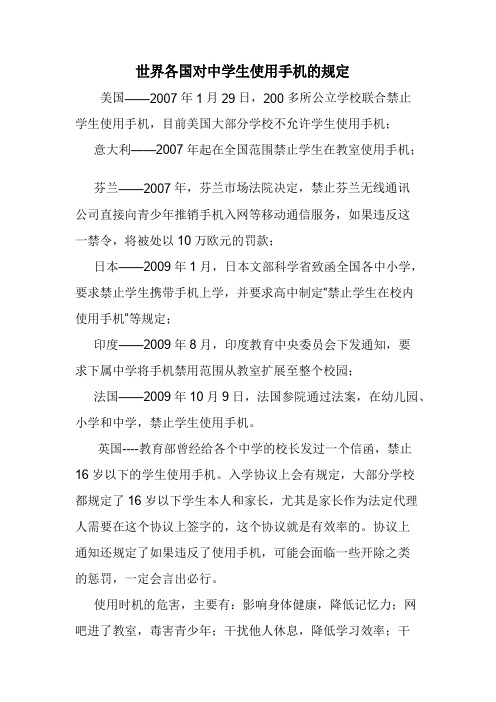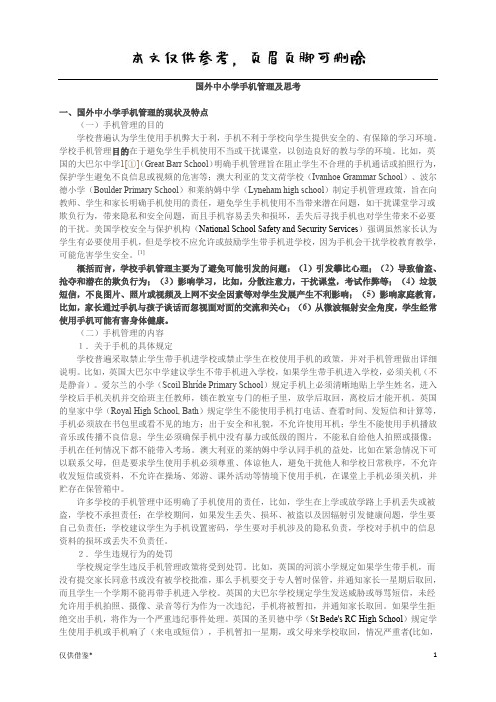看看国外如何处理中小学生使用手机
- 格式:docx
- 大小:15.40 KB
- 文档页数:3

学校手机管理的国际经验在当今这个数字化时代,手机已经成为了人们生活中必不可少的工具。
尤其是对于学生群体而言,手机已经渗透到学校的各个角落。
然而,由于课堂纪律的打破和学术欺诈等问题,学校手机管理变得尤为重要。
本文将探讨一些国际上成功运用的学校手机管理经验,并分析其可借鉴性。
首先,韩国可以被视为学校手机管理的典范。
在韩国的许多中学和高中中,实行了“手机盒子管理”制度。
每天上课前,学生需将手机放入由学校提供的个人手机盒子中,并将其锁住。
这样一来,学生们的课堂注意力完全集中在老师和学习上,手机的诱惑被有效地消除了。
这种管理方式既能保证学生参与课堂活动的质量,也能避免手机被用于作弊行为。
其次,美国的一些学校采取了“责任制手机管理”。
根据这种管理模式,学生有权在特定的课间休息时间或午餐时间使用手机,但他们需要对其负责。
如果学生没有把握好自己的使用时间,或者在课堂上使用手机,就会受到相应的惩罚。
这种管理方式注重培养学生的自我管理能力和责任感,让他们认识到手机的合理使用和学习的平衡。
除了韩国和美国,德国也有着一套独特的学校手机管理模式。
在许多德国学校,只允许学生在特定的时间和地点使用手机。
比如,在课间休息时间和午餐时间,学生可以在特定的手机使用区域使用手机。
而在课堂上,手机是完全禁用的。
这种分时分区的管理方式,既满足了学生对手机的需求,同时也保障了课堂的纪律和学习的质量。
另外,日本学校也有着自己独特的手机管理模式。
在日本,学校鼓励学生将手机交给老师保管,放置在统一的手机储存柜中。
学生们可以在放学后取回手机,并在放学前将其归还给老师。
这种管理方式强调了学校和家庭的合作,教育学生学会对自己手机的负责和管理。
综上所述,学校手机管理是一个全球范围内都存在的问题,各国学校都在探索适合自己的手机管理模式。
韩国的手机盒子管理、美国的责任制手机管理、德国的分时分区管理以及日本的老师保管制度,都是国际经验中的亮点。
这些经验都强调了学生的自我管理和课堂纪律的重要性,并且通过不同的管理方式达到了这一目标。

How to Tackle the Issue of Students' Excessive Mobile Phone UsageIn the modern era, the widespread availability and usage of smartphones have transformed our lives, bringing unprecedented convenience and connectivity. However, this technological revolution has also presented a significant challenge, especially for students. The excessive use of mobile phones among students has become a pressing issue that requires urgent attention and effective solutions.The problem of students' overuse of mobile phones is multifaceted. Firstly, it can lead to a significant distraction from academic pursuits, as students often find themselves engrossed in social media, gaming, or other forms of entertainment on their phones. This distraction can have a negative impact on their concentration, focus, and ultimately, their academic performance.Moreover, excessive mobile phone usage can also contribute to health issues. Prolonged screen time can strain eyesight, leading to vision problems. Additionally, students who are constantly on their phones may neglectphysical activities, leading to a sedentary lifestyle and potential health risks associated with it.To address this issue, a comprehensive approach is needed. Firstly, schools and parents should collaborate to set clear boundaries and expectations regarding mobile phone usage. This can include enforcing rules such as banning phones during class hours or limiting screen time after school. It is crucial to strike a balance between allowing students to enjoy the benefits of technology while also protecting them from its potential harms.Secondly, educational institutions can incorporate technology into their curriculum in a meaningful way. By integrating mobile phones and other digital tools into learning activities, students can be engaged in a more interactive and immersive learning experience. This approach not only reduces the temptation to use phones for non-academic purposes but also enhances their learning outcomes.Furthermore, it is essential to provide students with alternative activities that can occupy their time andfoster healthy habits. Encouraging participation in sports,cultural events, and other extracurricular activities can help students develop a more balanced lifestyle and reduce their reliance on mobile phones for entertainment.Lastly, it is crucial to educate students about the potential risks associated with excessive mobile phone usage. By raising awareness about the impact of screen time on health and academics, students can become more mindful of their usage habits and make informed decisions about their digital behavior.In conclusion, addressing the issue of students' excessive mobile phone usage requires a multi-faceted approach that involves collaboration between schools, parents, and students themselves. By setting boundaries, integrating technology into the curriculum, providing alternative activities, and educating students about the risks, we can help students strike a healthy balance between their digital lives and their academic and personal pursuits.**如何解决学生玩手机问题**在现代社会,智能手机的普及和使用极大地改变了我们的生活方式,带来了前所未有的便捷和连接性。

学生电子产品使用管理规定的国际经验与借鉴在全球范围内,学生电子产品使用管理规定属于学校管理中的一个重要课题。
许多国家和地区都制定了相应的实施方案,旨在帮助学生正确有序地使用电子产品,确保其学习效果和身心健康。
本文将介绍国际上一些国家的学生电子产品使用管理规定的经验和借鉴,以供我国参考借鉴。
一、美国的经验与借鉴在美国,许多学校都实行了针对学生使用电子产品的管理规定,其中比较典型的是加利福尼亚州的一些学校。
这些学校设立了专门的电子产品使用守则,规定学生在校园内只能在指定的时间和地点使用电子产品,比如在课间休息或午餐时间。
在教室内,学生需将电子产品关闭或静音,以免干扰教学秩序。
此外,美国还推行了在学生电子产品使用上的家校合作机制。
学校会与家长签订相关协议,明确学生使用电子产品的权限和责任,同时也要求家长监督和引导学生正确地使用电子设备。
这一政策的实施,既加强了学校对学生电子产品使用的监管,也促进了家校之间的沟通和配合。
与之类似的做法在其他美国地区也有所体现,总体来说,美国的学生电子产品使用管理规定注重于规范学生在学校和家庭中的行为,促进学生全面发展。
我国在实施学生电子产品使用管理规定时,可以借鉴美国的经验,建立起学校、家庭和学生之间的有效沟通机制,形成共同努力的良好氛围。
二、日本的经验与借鉴日本作为一个高度发达的国家,也在学生电子产品使用管理方面有着独特的经验和做法。
日本的学校对学生使用电子设备有着明确的规定,比如禁止在教室内使用手机、平板电脑等电子产品,以确保教学秩序。
同时,日本的学校还注重培养学生的自律意识,鼓励他们在课余时间选择适宜的活动,减少对电子产品的依赖。
此外,日本的学校还鼓励学生使用电子产品进行学习和创作。
一些学校开设了专门的电子产品课程,教导学生如何正确使用电子设备,开发学习效率。
同时,日本的学校还通过定期举办电子产品相关的讲座和活动,增强学生的科技意识和创新意识。
总的来说,日本在学生电子产品使用管理方面注重于引导学生积极地利用电子设备,促进其学习和成长。

世界各国对中学生使用手机的规定美国——2007年1月29日,200多所公立学校联合禁止学生使用手机,目前美国大部分学校不允许学生使用手机;意大利——2007年起在全国范围禁止学生在教室使用手机;芬兰——2007年,芬兰市场法院决定,禁止芬兰无线通讯公司直接向青少年推销手机入网等移动通信服务,如果违反这一禁令,将被处以10万欧元的罚款;日本——2009年1月,日本文部科学省致函全国各中小学,要求禁止学生携带手机上学,并要求高中制定“禁止学生在校内使用手机”等规定;印度——2009年8月,印度教育中央委员会下发通知,要求下属中学将手机禁用范围从教室扩展至整个校园;法国——2009年10月9日,法国参院通过法案,在幼儿园、小学和中学,禁止学生使用手机。
英国----教育部曾经给各个中学的校长发过一个信函,禁止16岁以下的学生使用手机。
入学协议上会有规定,大部分学校都规定了16岁以下学生本人和家长,尤其是家长作为法定代理人需要在这个协议上签字的,这个协议就是有效率的。
协议上通知还规定了如果违反了使用手机,可能会面临一些开除之类的惩罚,一定会言出必行。
使用时机的危害,主要有:影响身体健康,降低记忆力;网吧进了教室,毒害青少年;干扰他人休息,降低学习效率;干扰教学秩序,影响听课效率;严重败坏考风,彻底击跨学风;事端容易滋生,事故防不胜防。
严格控制手机,再严也不过分。
惩罚犯罪不是为了消灭犯罪,而是为了减少犯罪,对于学生在校使用手机也应该是这种态度。
严格控制手机,再严也不过分。
控制手机的目的并不是为了消灭手机,而是减少手机,或者是减少手机的使用次数,我们觉得,以控制不住为理由对手机的使用采取默许的态度,实际上是对学生的纵容,是不落实学校规定的懒汉做法。
手机的过度使用会增加学生的闲事,分散学习精力,败坏学习风气。
手机虽然方便了家长与学生的联系,但却严重地影响了学校的管理和学生的学习,对中学生来讲害处远远大于益处。
手机功能越来越多,视频、聊天、上网、下载、发短信、玩游戏等,特别是智能手机的出现和逐渐普及,已经使手机变成了一个微型网吧。

国外中小学手机管理及思考一、国外中小学手机管理的现状及特点(一)手机管理的目的学校普遍认为学生使用手机弊大于利,手机不利于学校向学生提供安全的、有保障的学习环境。
学校手机管理目的在于避免学生手机使用不当或干扰课堂,以创造良好的教与学的环境。
比如,英国的大巴尔中学1[①](Great Barr School)明确手机管理旨在阻止学生不合理的手机通话或拍照行为,保护学生避免不良信息或视频的危害等;澳大利亚的艾文荷学校(Ivanhoe Grammar School)、波尔德小学(Boulder Primary School)和莱纳姆中学(Lyneham high school)制定手机管理政策,旨在向教师、学生和家长明确手机使用的责任,避免学生手机使用不当带来潜在问题,如干扰课堂学习或欺负行为,带来隐私和安全问题,而且手机容易丢失和损坏,丢失后寻找手机也对学生带来不必要的干扰。
美国学校安全与保护机构(National School Safety and Security Services)强调虽然家长认为学生有必要使用手机,但是学校不应允许或鼓励学生带手机进学校,因为手机会干扰学校教育教学,可能危害学生安全。
[1]概括而言,学校手机管理主要为了避免可能引发的问题:(1)引发攀比心理;(2)导致偷盗、抢夺和潜在的欺负行为;(3)影响学习,比如,分散注意力,干扰课堂,考试作弊等;(4)垃圾短信,不良图片、照片或视频及上网不安全因素等对学生发展产生不利影响;(5)影响家庭教育,比如,家长通过手机与孩子谈话而忽视面对面的交流和关心;(6)从微波辐射安全角度,学生经常使用手机可能有害身体健康。
(二)手机管理的内容1.关于手机的具体规定学校普遍采取禁止学生带手机进学校或禁止学生在校使用手机的政策,并对手机管理做出详细说明。
比如,英国大巴尔中学建议学生不带手机进入学校,如果学生带手机进入学校,必须关机(不是静音)。

国外小学生手机管理制度首先,让我们来看一些国外小学的手机管理制度。
一般来说,这些小学都有明确的规定,比如学生在上课期间不能使用手机,包括放学后的时间。
另外,学校也会规定在学校内的特定区域才能使用手机,比如休息时间或者课间时间。
对于违反规定的学生,学校会有相应的处罚措施,比如没收手机或者罚款等。
此外,学校也会积极与家长合作,要求他们在家庭中对孩子的手机使用进行管理,确保他们在学校以外的时间也不会沉迷于手机。
这种手机管理制度的实施对于小学生的成长有着积极的影响。
首先,它可以帮助小学生更好地专注于学习。
在上课期间,学生如果随意使用手机,会分散注意力,影响学习效果。
而如果在放学后,学生沉迷于手机游戏或社交网络,也会影响他们完成作业和与家人交流的时间。
因此,规定学生在学习时间不能使用手机,有助于他们更好地专注于学业。
其次,这种管理制度也可以帮助学生养成健康的生活习惯。
在学校规定的时间内不能使用手机,可以让学生有更多的时间参与体育活动、户外游戏或者与同学进行交流。
这样有助于他们保持健康的身体,培养合作精神和社交能力。
另外,这也可以避免学生长时间沉迷于手机而忽略了其他方面的发展。
除此之外,手机管理制度也可以帮助学生建立正确的价值观和消费观念。
如果学生过度沉溺于手机游戏或社交网络,容易形成消费主义的观念,认为手机和虚拟社交可以带来快乐,这对于他们的成长是不利的。
而如果学校规定学生在学校内不能使用手机,并且有相应的处罚措施,可以让学生明白手机只是一种工具,而不是生活的全部。
这种正确的价值观和消费观念对于他们的成长和未来都是非常重要的。
然而,尽管手机管理制度有很多积极的方面,但也有一些人对其提出了质疑。
一些家长和学生认为,手机对于学生来说也有一些积极的作用,比如可以方便他们与家长联系,也可以帮助他们在学习中查找资料。
而且,一些家长认为,他们希望通过手机来监督孩子的行踪和安全。
因此,他们觉得学校对于手机使用的管理过于严格,会限制孩子的发展。
如何解决学生玩手机问题英语作文全文共3篇示例,供读者参考篇1How to Solve the Problem of Students Playing with PhonesNowadays, smartphones have become an essential part of modern life, and students are no exception. Many students spend a significant amount of time playing games, chatting with friends, or browsing social media on their phones, which can be a major distraction in the learning environment. As educators and parents, it is important for us to address this issue and find effective solutions to help students focus on their studies.One way to tackle the problem of students playing with phones is to involve parents in the process. Parents play a crucial role in shaping their children's behavior and habits, so it is important to educate them about the negative impacts of excessive phone use on academic performance. Schools can organize workshops or seminars for parents to raise awareness about the issue and provide practical tips on how to limit their children's phone usage.Another effective solution is to create a phone-free policy in schools. By implementing strict rules that prohibit the use of phones during class time or in certain areas of the school premises, students will be less tempted to sneakily use their phones. Teachers and school staff can monitor compliance with the policy and enforce consequences for students who violate the rules, such as confiscating their phones or assigning extra work.Furthermore, schools can also introduce alternative activities to keep students engaged and entertained during breaks or free periods. Setting up designated areas for socializing, physical activities, or creative projects can provide students with a healthier and more productive way to spend their time instead of being glued to their phones. Encouraging students to participate in extracurricular activities, such as clubs, sports teams, or music groups, can also help them develop new interests and build meaningful relationships with their peers.In addition, it is important for schools to educate students about the importance of time management and self-discipline. Teaching students how to prioritize their tasks, set goals, and allocate their time effectively can help them balance their academic responsibilities with their personal interests, includingphone use. Schools can offer workshops or courses on study skills, organization, and digital literacy to empower students to manage their time more efficiently and develop healthy habits.Moreover, parents and teachers should lead by example and demonstrate responsible phone use to students. By showing respect for boundaries and using phones mindfully in front of students, adults can set a positive role model for young people to follow. Educating students about digital etiquette, privacy, and cybersecurity can also help them understand the potential risks and consequences of irresponsible phone use.Ultimately, solving the problem of students playing with phones requires a collaborative effort between parents, educators, and students themselves. By promoting awareness, setting clear boundaries, providing alternative activities, teaching time management skills, and modeling responsible behavior, we can help students develop a healthy relationship with their phones and prioritize their academic success. Together, we can create a supportive and engaging learning environment where students can thrive and reach their full potential.篇2How to Solve the Problem of Students Playing with PhonesIn today's digital age, smartphones have become an essential part of our daily lives. While smartphones have brought many benefits, they have also created some challenges, particularly in the classroom. Students are increasingly turning to their phones during class time, which can be disruptive to learning. As educators and parents, it is important for us to address this issue and find effective solutions. In this essay, we will explore how to solve the problem of students playing with phones in the classroom.First and foremost, it is crucial for schools to establish clear policies regarding phone usage. Teachers should clearly communicate the expectations for phone use in their classrooms and enforce consequences for students who violate these rules. By setting boundaries and holding students accountable, schools can create a more structured learning environment that discourages phone use during class time.Furthermore, schools can implement technology-free zones or periods during the school day. For example, schools can designate certain areas of the school where phones are not allowed, such as in the classroom or during lunch hour. By creating designated spaces for phone-free activities, schools canhelp students break the habit of constantly checking their phones and encourage more face-to-face interaction.In addition, schools can provide alternative activities to keep students engaged and focused during class time. For example, teachers can incorporate interactive lessons, group projects, or hands-on activities that require students to actively participate. By providing engaging and interactive learning experiences, schools can help students stay focused and reduce the temptation to use their phones.Moreover, schools can educate students about the negative effects of excessive phone use. Teachers can discuss the impact of phone addiction on mental health, academic performance, and social relationships. By raising awareness about the risks associated with excessive phone use, schools can empower students to make more informed decisions about their phone habits.In conclusion, the problem of students playing with phones in the classroom is a complex issue that requires a multifaceted approach. By implementing clear policies, creating technology-free zones, providing alternative activities, and educating students about the risks of excessive phone use, schools can effectively address this problem and create a morefocused and productive learning environment. It is essential for educators, parents, and students to work together to find solutions that promote responsible phone usage and enhance the overall learning experience.篇3How to Solve the Problem of Students Playing with PhonesIn recent years, the issue of students playing with phones in class has become a serious concern for teachers and parents alike. The constant distraction of mobile devices can negatively impact students' learning and academic performance. In order to address this problem, it is important for educators, parents, and students themselves to work together to find effective solutions.First and foremost, teachers play a vital role in preventing phone usage in the classroom. Setting clear rules and expectations regarding phone usage during lessons is essential. Teachers should establish consequences for students who are caught using their phones during class, such as confiscating the device or assigning additional homework. By enforcing these rules consistently, teachers can help students understand the importance of staying focused on their studies.In addition to teachers' efforts, parents also play a key role in addressing the issue of phone usage among students. Parents should monitor their children's phone usage at home and set limits on screen time. By establishing clear boundaries and encouraging alternative activities, such as reading or engaging in physical exercise, parents can help reduce their children's dependency on mobile devices.Furthermore, students themselves must take responsibility for their own behavior. It is important for students to recognize the negative impact that excessive phone usage can have on their academic performance and overall well-being. By practicing self-discipline and limiting their phone usage during class time, students can improve their focus and concentration, leading to better learning outcomes.Another effective strategy for addressing the issue of phone usage among students is to incorporate technology into the classroom in a positive and engaging way. For example, teachers can use educational apps and interactive learning platforms to enhance students' understanding of the material and encourage active participation. By integrating technology into lessons in a meaningful way, teachers can harness students' natural interestin mobile devices and channel it towards productive learning activities.In conclusion, the problem of students playing with phones in class can be effectively addressed through a combination of measures implemented by teachers, parents, and students themselves. By setting clear rules and consequences, monitoring phone usage at home, practicing self-discipline, and using technology in a positive way, it is possible to create a conducive learning environment that fosters academic success and personal growth. By working together, we can help students overcome the distraction of mobile devices and reach their full potential in the classroom.。
环球27喧嚣的博弈:国外校园手机禁令出台背后文_毛柳笛 杨光富 设计_张光伟2023年12月,新西兰新任总理克里斯托弗·拉克森宣布,将推动全国中小学校禁用手机,从而消除手机干扰课堂秩序的现象,让学生专心上课。
在此之前,法国、美国加利福尼亚州、加拿大安大略省、澳大利亚维多利亚州都先后通过立法出台了中小学校禁用手机的法律法规。
随着智能手机使用的日益低龄化,一场针对手机能否进课堂或校园的博弈号角已吹响。
手机并非第一个被认为需要禁止进入学校的物品,却是最具争议性、难以达成各方共识的物件。
关于是否禁止手机进入校园,2022年澳大利亚数据机构Essential Research 调查了1070名受访者,数据显示,2/3的受访者强烈支持或部分支持应该教育和引导学生安全使用手机,而不是禁止学生在学校使用手机;37%的人支持或有些支持只允许11年级和12年级的学生在学校使用手机。
校园手机禁令支持者vs 反对者校园手机禁令的支持者认为,学校禁用手机将有利于解决五方面的问题。
第一是手机成瘾。
澳大利亚国会议员乔治·克里斯滕森(George Christensen )认为,手机对于青少年的影响类似于毒品。
英国通信管理局(Ofcom )早在2011年的一份调查显示,有超过60%的青少年对智能手机“过度上瘾”,他们使用智能手机的地点无所不在。
第二是网络霸凌。
校园霸凌一直以来是学校重点关注却又难以根治的沉疴痼疾,而网络霸凌更是将这一问题推向了隐蔽幽微、难以勘察之地。
网络霸凌事前难以察觉、事中难以控制、事后难以追责的特性,让学校难以及时有效地进行防御和管控。
美国独立调查机构皮尤研究中心于2022年4月进行的一项调查显示,46%的13—17岁的美国青少年曾不同程度地经历过网络欺凌。
禁止在校园内使用智能手机,可以显著减少在校网络霸凌事件的发生。
2017年,研究者通过监测17个西班牙地区的区域级面板数据,对颁布手机禁令地区和未颁布手机禁令地区的网络霸凌数据进行比较分析,发现颁布手机禁令地区的青少年欺凌事件明显减少。
西方各国在学生带手机问题上的规定
教育园圃
11-12 1452
:
大约在10年前,美国各州的学区纷纷制定规则(有些是州议会或地方政府立法),完全取缔在校学生使用传呼机和手机。
芬兰:禁止向青少年推销手机。
芬兰市场法院近日决定,禁止芬兰无线通讯公司直接向青少年推销手机入网等移动通信服务。
如果违反这一禁令,将被处以10万欧元的罚款。
英国禁止16岁以下学生使用手机。
鉴于使用手机有可能会对健康构成威胁,英国教育部已经致函各学校的校长,明确表示除了紧急情况之外,16岁以下的学生不准使用手机。
鉴于目前校园内手机泛滥,已严重影响了中小学生的学习和身心健康,建议立法禁止中小学生将手机带入校园。
龙源期刊网
欧洲多国限制中小学生在校使用手机
作者:
来源:《中小学德育》2018年第08期
随着电子产品的普及,学生用手机、玩“平板”日渐成为学校、家庭共同面临的教育话题。
沉溺手机者呈现“低龄化”趋势。
很多中小学生在学校频繁使用手机,一定程度上影响了其学习和生活。
为减少电子产品对学生成长的干扰,不少国家采取了限制使用的措施。
意大利是欧洲第一个禁止学生上课时使用手机的国家,早在2007年,意大利就颁布了一道全国禁令,一旦发现学生在校违规使用手机,在劝说无效的情况下,校方可视情节轻重,对学生处以没收手机或取消期末考试资格等惩罚。
希腊教育部近期也宣布,将禁止中小学生在校园内使用电话及其他电子设备,尤其是可以处理图形图像和声音的设备。
同时,教师使用的台式电脑、笔记本电脑、平板电脑等设备也将由学校提供。
英国教育标准局前首席执行官表示,英国的“手机禁令”已推广到大多数中小学校。
根据英国教育部的数据,目前英格兰地区已有95%的学校实行了类似禁令。
比利时法语区义务教育总司协调局负责人表示,在比利时法语区,政府的立场是倡导教育与预防教育相结合,既要引导学生正确认知自己的“数字身份”,了解相关法律和需要承担的责任和义务,预防潜在错误行为产生;同时也要借规范学生使用电子产品的契机,指导其学习正确地运用媒体。
(来源:人民网2018年7月17日)。
同学们,看看国外如何处理中小学生使用手机?
英国限制16岁以下儿童使用手机
英国政府曾向全国所有中小学寄出一封警示信,指出儿童使用移动电话会对其健康造成潜在危害。
英国教育大臣督促所有中小学校校长,严格限制16岁以下的学生使用移动电话,除非遇到紧急情况才能使用移动电话。
因为“儿童大脑16岁前一直处于发育阶段,任何来自辐射的危险都很容易对其造成伤害”。
芬兰禁止向青少年推销手机服务
芬兰法院决定,禁止芬兰无线通讯公司直接向青少年推销手机入网等移动通信服务。
违反这一禁令者,将被处以最高10万欧元的罚款。
2011年,芬兰儿童保护协会还与芬兰媒体教育中心和家长协会合作,在芬兰所有的基础学校(相当于中国的小学和初中)为一二年级学生及家长、老师举办讲座和主题日活动,旨在指导儿童正确使用手机和电脑;并专门为一年级学生建立了电子游戏网站,提供适合他们玩的游戏和使用手机的相关提示。
意大利禁止学生在教室使用手机
意大利颁布命令,禁止学生在教室里使用手机,目的是为了避免手机铃声扰乱课堂秩序,并防止学生使用摄像头胡乱拍照。
规定还要求学校惩罚那些不听劝阻,坚持在课堂使用手机的学生,具体措施包括没收手机
和期末考试不予通过等。
意大利教育部长说,如果违规情况严重并产生了一定的法律后果,或危及安全,应考虑采取更严厉的惩罚措施。
日本禁止中小学生携带手机上学
2009年,日本文部科学省致函全国各中小学,要求禁止学生携带手机上学,并要求高中制定禁止学生在校内使用手机的规定。
而一些私立学校则由学校统一购置学生定制手机,上课期间统一关机。
该公函指出,中小学生携带手机上学,不仅影响学习,将会导致色情、暴力以及学生相互欺负的有害信息泛滥,给学生身心健康带来恶劣影响。
草案建议手机开发商生产专供中小学生使用的简易手机,功能包括限定通话对象等,以满足家长紧急联络学生的需要。
美国学校禁止学生使用手机
早在2000年,美国各州的学区纷纷制订规则,完全取缔在校学生使用
传呼机和手机。
2007年1月29日,美国200多所公立学校联合禁止学生使用手机。
目前美国大部分学校不允许学生使用手机。
佐治亚州在下午3时放学之前严禁学生使用手机。
一旦学生违反规定,老师可以将手机没收,并对当事者进行违纪处理。
韩国限制青少年长时间使用手机
鉴于韩国青少年日益高涨的手机费用已成为众多家长头痛的问题,韩国政府不得不颁布法律,对青少年使用手机进行监管。
法律规定,韩国青少年手机用户要签订一份单独合约,要求他们和父母一起参加手机费用封顶计划。
该计划控制青少年手机用户每月使用的手机费用不能超过40美元。
此外,合约还就如何节省手机费用向青少年和他的父母提供建议。
《中国教育报》2013年11月5日第3版。